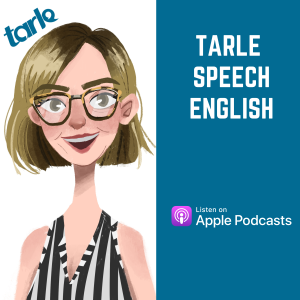Jennifer Tarle's Blog, page 4
June 26, 2023
Now on Apple Podcasts – The Tarle Speech English Pronunciation Podcast
Listen to the Tarle Speech English Pronunciation Podcast on Apple Podcasts
The post Now on Apple Podcasts – The Tarle Speech English Pronunciation Podcast appeared first on Tarle Speech.
Now on Spotify – The Tarle Speech English Pronunciation Podcast
Listen to the Tarle Speech English Pronunciation Podcast on Spotify.
The post Now on Spotify – The Tarle Speech English Pronunciation Podcast appeared first on Tarle Speech.
Listen to the Tarle Speech English Pronunciation Podcast
Download and listen today!
The post Listen to the Tarle Speech English Pronunciation Podcast appeared first on Tarle Speech.
June 23, 2023
How to Pronounce CONVERT & CONVERT – American English Heteronym Pronunciation Lesson
Learn how to pronounce the words CONVERT & CONVERT with this American English pronunciation lesson. Learn the sounds and syllable stress needed to be clear and understood.
Definitions:a person whose belief has changed or to change one’s beliefsPronunciation:
ˈkɑnvɜrt
kənˈvɜrt
Playlist: Tutorials 👩🏻🏫 FREE English Pronunciation Classes 👩🏻🏫 Tarle Speech
The post How to Pronounce CONVERT & CONVERT – American English Heteronym Pronunciation Lesson appeared first on Tarle Speech.
June 21, 2023
5 Second Rule by PlayMonster – Language Learning Game Recommendation
Today’s language learning game recommendation is 5 Second Rule by PlayMonster.
The game is designed for 3+ players. It is marketed for ages 10 and up. It is tough for some 10 year olds and in my opinion, it is better for 12 and up. There is also a kids version for ages 6+ and a Disney version also for ages 6+.
Here is how I play. Name three items in a category in 5 seconds or less.
The game comes with a timer, that I think is very annoying, but kids love it. Read the clue, turn over the timer, then the player or team need to name 3 items as fast as they can to beat the clock!
The games for the younger kids, kids version and Disney version, come with a game board, but I never use it.
The game encourages fast thinking for vocabulary.
This makes a great speech therapy game for various ages, ESL game, or family game. Get yours today!
Currently, the game costs $19.82 on Amazon.
The post 5 Second Rule by PlayMonster – Language Learning Game Recommendation appeared first on Tarle Speech.
How to Pronounce PAIN & PANE – American English Homophone Pronunciation Lesson
Learn how to pronounce the words PAIN & PANE with this American English Homophone pronunciation lesson. These words are pronounced the SAME way but have different meanings and different spellings.
Definitions:
PANE a sheet of glass
PAIN emotional or physical suffering
Pronunciation: These words are pronounced the SAME way: /peɪn/
Products, classes, and socials
Products, classes, and socials: https://linktr.ee/tarlespeech Playlist: HOMOPHONES – words spelled differently, with different meanings, but are pronounced the same way.
Improve your accent, speak clearly, and improve your speaking confidence with this English pronunciation lesson. Learn how to pronounce English words correctly with Jennifer Tarle from Tarle Speech and Language. Lessons guide you through a quick pronunciation lesson with practice examples. Learn quick tips to have you sounding clearer in no time. Reduce your accent, gain confidence, and speak clearly today!
The post How to Pronounce PAIN & PANE – American English Homophone Pronunciation Lesson appeared first on Tarle Speech.
June 13, 2023
How to Pronounce SENSOR, CENSOR, CENSER – American English Homophone Pronunciation Lesson
Learn how to pronounce the words SENSOR, CENSOR, CENSER with this American English Homophone Pronunciation Lesson. These words are homophones and are pronounced exactly the same way.
Definitions:SENSOR – a device which detects or measures a physical property and records, indicates, or otherwise responds to it
CENSOR – to suppress or a person who judges if material is appropriate or not
CENSER – a container in which incense is burned
Pronunciation:These words are pronounced exactly the same way!
/ˈsɛnsər /
This may be helpful:Two for Tuesday✌️Learn English HOMOPHONE Pronunciation
Transcript:Hello Jennifer from Tarle speech with your two for Tuesday homophone lesson. Homophones are words that are pronounced exactly the same way. Yes exactly the same way. We just have different spellings and different meanings.
We have three words today – two common words, one word that I just learned, I didn’t even know this was a word.
So we have
sensor which means to suppress or a person who decides what is unacceptable
censor a device that detects or measures things and a
senser, I didn’t know this, which is a container in which incense is burned – I didn’t know that um, so I think that’s very interesting.
So to say these words correctly we have two syllables or two beats. We’re going to start with sen and to do this your tongue is going to be behind your top teeth or just pointing down to the bottom of your mouth. It’s not touching for that s. Air is going to continue out of your mouth.
Next move to that short e sound. To do this you should just be able to see the tip of your tongue between your top and your bottom teeth for that e sound. Then touch the tip of the tongue to the back of the top front teeth. Where the skin meets the teeth at the roof of the mouth for that n – air is going to move out of your nose. Sen sen
Now for sir. You’re going to start with that s again and then end with the ER. Square tense lips, tip of the tongue is down, back of the tongue is pulled way high up. You can also flip the tip of the tongue back if that works better for you. Just make sure that you don’t touch your teeth and that your tongue does not move for that ER. Let’s put that syllable number two together sir sir.
Sen Zer sensor censor senser sensor censor
And now for a sentence:
The censor used a sensor to measure the senser’s temperature.
The censor used a sensor to measure the senser’s temperature.
Give it a try I know people are going to notice the difference.
If you need help you can check us out at tarle speech or link tree in the description below.
Thank you everyone have a great week!
The post How to Pronounce SENSOR, CENSOR, CENSER – American English Homophone Pronunciation Lesson appeared first on Tarle Speech.
June 8, 2023
How to Pronounce CONTEST & CONTENT – American English Pronunciation Lesson
Learn how to pronounce the words CONTEST and CONTENT with this American English heteronym pronunciation lesson. Heteronyms are words that are spelled exactly the same. They just have a different pronunciation and a different meaning.
Pronunciation:Nouns: ˈkɒntɛst ˈkɒntɛnt
Verbs: kənˈtɛst kənˈtɛnt
Definition:contest: a noun meaning a match; a verb meaning to argue
content: a noun meaning subject matter; verb meaning satisfied
Transcript:It’s Jennifer from Tarle speed with your question of the week. I’m finishing up my heteronym series and I have two sets of words for you today with the same pattern. We have content which is a noun meaning subject matter or content a verb meaning satisfied and contest which is a match or competition. And contest to argue.
So if I could get my board correct here. Here are the words. I wrote this a little bit differently today because we’re going to take a different approach. I want you to think just about the word stress today not so much about the individual sounds.
A general rule with heteronyms is that we stress syllable number one in nouns and adjectives and we unstressed syllable number two. We stress syllable number two in verbs and we unstress syllable number one. A stressed syllable is louder longer and higher in pitch and the unstressed syllable this is just as important is lower softer and shorter. You will see.
When we have words that start with the letters c o n for syllable number one when we stress it we’re really going to pronounce the vowel and we’re going to say con. However, when that syllable is unstressed we’re going to use the short uh sound and say Kun. That’s a great general rule of thumb.
So let’s give these words a try. We have content which is the noun and contest. So let’s stress syllable number one in content and contest. content contest.
Now if we’re using these as verbs we can say content and contest content contest. Now let’s give all of those a try.
Let’s try the nouns first. content content content contest contest contest and now for the verbs content content content contest contest contest.
So I’m going to do the noun first and then the verb. We have content content contest contest.
And now for a few sentences: I hope you are content with the content of my channel. I really hope you are give me a thumbs up if you are. And then for contest we have, the team will contest the winner of the contest.
So give it a try I know people are going to notice the difference let me know what you thought about this new format and if you have any requests I have a great weekend everybody take care!
The post How to Pronounce CONTEST & CONTENT – American English Pronunciation Lesson appeared first on Tarle Speech.
June 6, 2023
How to Pronounce CURRENT & CURRANT – American English Homophone Pronunciation Lesson
Learn how to pronounce the words CURRENT & CURRANT with this American English Homophone pronunciation lesson. These words are pronounce the SAME way but have different meanings and different spellings.
Definitions:CURRENT – happening or being used or done now; movement of water or air
CURRANT – a small dried fruit
Pronunciation:These words are pronounced the SAME way: /ˈkɜrənt /
This may be helpful:Two for Tuesday✌️Learn English HOMOPHONE Pronunciation
Transcript:It’s Jennifer from Tarle speech with your two for Tuesday homophone lesson. Homophones are words that are spelled differently and they have different meanings but they are pronounced the same. Our words today are:
currant a small dried fruit and
current the present time movement of air or water or the flow of electricity
So we have two syllables or two beats in these words today. So let’s start with syllable number one – Cur.
And to say this tip of your tongue is going to be low in your mouth back of your tongue will be pulled high up. Air just Puffs out K. then keep your tongue in that same spot for Most of you. You can flip the tip of your tongue back for that R, if you need to just don’t touch your teeth. And let’s put those two together KER
If you say a W for the sound accidentally make sure that your lips are pulled back into a square tense shape. And that should help KER.
Then we’re going to end with runt again start with that R. We’re actually going to connect it. We’re not actually going to say it twice. This has been helping some of my students. Then relax the mouth for that uh. Touch the tip of the tongue to the back of the top front teeth for that n. Air moves out of your nose. Then pull the tongue down and let the air puff out for the t.
runt runt runt
Let’s put it all together
KER
RUNT
ker runt
current currant
current currant
current currant
current currant
And now for a sentence the currant floated Downstream on the current.
Give it a try people are going to notice the difference. Thanks so much everyone!
The post How to Pronounce CURRENT & CURRANT – American English Homophone Pronunciation Lesson appeared first on Tarle Speech.
May 30, 2023
How to Pronounce BURROW & BOROUGH – American English Homophone Pronunciation Lesson
Learn how to pronounce the words BURROW & BOROUGH with this American English Homophone Pronunciation Lesson. These words are homophones and are pronounced exactly the same way.
Definitions:BURROW – to dig a tunnel or a tunnel for an animal
BOROUGH – a town or district that is an administrative unit
Pronunciation:These words are pronounced exactly the same way!
/ˈbɜroʊ /
This may be helpful:Two for Tuesday✌️Learn English HOMOPHONE Pronunciation
Transcript:Hello it’s Jennifer from Tarle speech with your two for Tuesday homophone lesson. Homophones are words that are pronounced exactly the same. They just have different spellings and different meanings. We have two words today:
burrow which is a whole dug by a small animal or to dig a tunnel and
Borough a town or an administrative District
So to say these words correctly, we have two syllables. Let’s start with Br. To say this lips together then open them for that b sound. While the air Puffs out. Then move to square tense lips for that ER – tip of the tongue is down, back of the tongue is pulled high up. You can also flip the tip of the tongue back that works fine too just make sure you don’t touch your teeth, and the tip of your tongue does not move. br
Syllable number two is o. You can just say Burr o that’s fine. But recently I’ve been saying that it’s helping my students to think of having two r’s there. So that you connect those syllables clearly. So to say the o sound you’re going to open in a wide oval then move to a pucker. Tongue starts low in the mouth with that tongue tip way low. Back of the tongue pulled high up and then ends in the middle of the mouth – o.h
Put it all together ber-o ber -o
burrow borough burrow
burrow borough burrow
And now for a sentence:
A prairie dog burrow was found under the borough building.
Give it a try people will notice the difference. I hope you found this helpful. If you did please share us with your friends. Maybe leave us a comment and give us a like. If you need more help we have products and classes listed in the description and the link tree.
Thanks so much everyone have a great week!
The post How to Pronounce BURROW & BOROUGH – American English Homophone Pronunciation Lesson appeared first on Tarle Speech.





